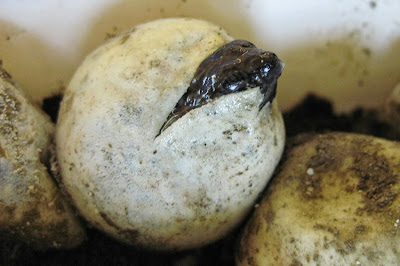 |
| The exposed Snapping Turtle nest. |
Unexpected discoveries are to be expected when spending time
in nature. You go out looking for one
thing and find another. When I was
checking a crayfish trap (which turned out to be empty) just downstream from
NBNC last week, I was thrilled to discover a nest of Snapping Turtles in the
process of being born.
I first noticed some very fresh looking egg shells at the base
of a large dirt pile. I could tell they
were fresh because the leathery shells had not yet curled up as they do when
they begin to dry out. At the top of the
dirt pile was a cave-like opening about the size of a slice of bread, inside
which eggs and baby turtles were piled and partially buried. Some had already hatched, others were
hatching, and some were still sealed in the ping pong ball sized eggs.
 |
| One of the Snapping Turtles just beginning to emerge. |
Hatchling Snapping Turtles are extremely vulnerable and can
become a bite-sized snack for a slew of creatures such as raccoons, otters,
herons, kingfishers, crows, bullfrogs, bass, snakes, and even other
turtles. Under natural conditions, few
nestlings will survive to adulthood, but these conditions were far from
natural. The nest was completely
exposed, elevated above the ground on top of the mound of soil, open and
exposed to the baseball diamond. Crows
frequent this area, searching for scraps left by people, and would gobble up
baby turtles in an instant. So I decided
to excavate the nest and watch over the turtles until they had all hatched.
 |
| A hatchling almost out of its shell. |
Over the next few days, the baby turtles emerged from their
eggs. They pried through the leathery
shells using their egg tooth (the sharp, white tip of their beak), which will disappear
as they grow. Even with my help, most of
these turtles will likely become prey for other creatures. Very few hatchlings make it to adulthood, but
those that do have few natural predators and can live for decades. I wished them luck as I released them into
the beaver pond near NBNC. Hopefully in
ten years I will see one of them as an adult, enjoying life along the North
Branch of the Winooski River.
 |
| Ready for release at the beaver pond. |



























